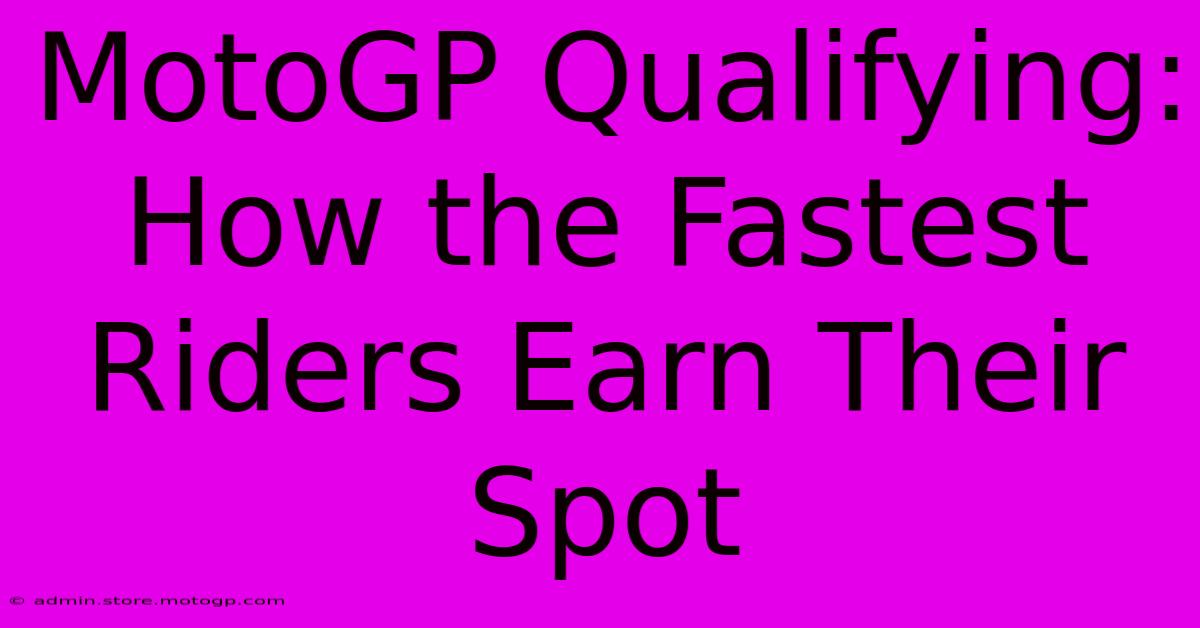MotoGP Qualifying: How The Fastest Riders Earn Their Spot

Table of Contents
MotoGP Qualifying: How the Fastest Riders Earn Their Spot on the Grid
MotoGP qualifying is a crucial part of the weekend, determining the starting positions for the Grand Prix race. The fight for pole position is intense, with riders pushing their machines and themselves to the absolute limit. But how exactly does this high-stakes qualifying process work? This article breaks down the intricacies of MotoGP qualifying, explaining how the fastest riders earn their coveted spot on the front row and beyond.
Understanding the Qualifying Format
The current MotoGP qualifying format is designed to create drama and excitement, rewarding consistency and ultimate speed. It consists of three sessions:
FP1 & FP2 (Free Practice):
These two sessions are crucial for setting the stage. Teams gather valuable data on tire performance, bike setup, and track conditions. While these sessions don't directly determine starting positions, they are essential for preparing for the all-important qualifying sessions. Data collected here informs strategies for the later stages of the weekend.
FP3 (Free Practice 3):
FP3 acts as a final practice session and a crucial determinant for Q1 and Q2. The top 10 riders from the combined times of FP1, FP2, and FP3 automatically progress to Q2. This means that even a strong performance in FP3 can be enough to secure a coveted spot in the second qualifying session, bypassing the pressure cooker of Q1.
Q1 (Qualifying 1):
This session features the 15 riders who did not finish in the top 10 of the combined FP practices. It's a high-pressure, elimination-style session where only the two fastest riders gain entry into Q2. Every tenth of a second counts, and the tension is palpable as riders fight for their survival in the race for the coveted Q2 spots. Mistakes are heavily penalized, highlighting the significance of precision and experience.
Q2 (Qualifying 2):
Q2 is where the real battle for pole position begins. The top ten riders from FP1, FP2, and FP3 are joined by the two fastest riders from Q1. These 12 riders have 15 minutes to set their fastest lap time possible. The rider with the fastest lap secures pole position, starting the race from the most advantageous spot on the grid. Positions 2 and 3 on the grid also greatly influence race strategy and outcome.
The Importance of Qualifying Performance
A strong qualifying performance can significantly impact a rider's chances of winning the race. Starting from the front row gives riders a considerable advantage, allowing them to control the race from the outset. Avoiding the initial chaos and wheel-to-wheel battles at the start is a massive advantage, often leading to a cleaner, more strategic race.
Furthermore, a good starting position can significantly affect the overall race strategy. Riders can tailor their race plan to conserve tires or manage fuel knowing they start ahead. Conversely, starting further down the grid necessitates a more aggressive strategy, potentially increasing the risk of crashes or mistakes in overtaking maneuvers.
Factors Influencing Qualifying Performance
Numerous factors contribute to a rider's success in qualifying:
- Bike Setup: A perfectly tuned bike is paramount. Even minor adjustments can significantly impact lap times.
- Tire Choice: Selecting the right tires for the track and weather conditions is crucial.
- Track Conditions: The track's temperature and grip level directly influence performance.
- Rider Skill & Experience: The rider's skill in pushing the bike to its limits and maintaining consistency is ultimately the deciding factor.
- Team Strategy: The team’s approach to tire management, fuel strategy, and data analysis plays a vital role.
Conclusion
MotoGP qualifying is far more than just a time trial. It's a tense, strategic battle showcasing the peak of motorcycle racing skill and technological prowess. Understanding the intricacies of the format and the factors impacting performance provides deeper appreciation for the drama and excitement leading up to the race itself. The riders who master these elements are rewarded with prime grid positions, giving them a significant advantage in the pursuit of victory.

Thank you for visiting our website wich cover about MotoGP Qualifying: How The Fastest Riders Earn Their Spot. We hope the information provided has been useful to you. Feel free to contact us if you have any questions or need further assistance. See you next time and dont miss to bookmark.
Featured Posts
-
Yamaha Moto Gp Can They Catch The Leaders Team News
Feb 17, 2025
-
Malaysia Moto Gp An Unforgettable Adventure
Feb 17, 2025
-
The Science Of Speed Moto Gp Horsepower Analyzed
Feb 17, 2025
-
Best Moto Gp Riders A Guide For New Fans
Feb 17, 2025
-
Moto Gp Vs F1 A Clash Of Cultures
Feb 17, 2025
